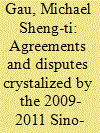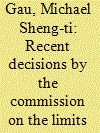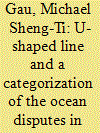| Srl | Item |
| 1 |
ID:
148527


|
|
|
|
|
| Summary/Abstract |
This paper examines the evidences used by the Tribunal for the South China Sea Arbitration to conclude that Philippines’ Submissions 3-4 and 6-7 reflect disputes. The Jurisdictional Award uses certain notes verbales sent by the Philippines and China in April 2011 for this purpose. However, the plain wording of these notes verbales negates the existence of disputes concerning the legal status of nine maritime features identified by those four Submissions. The Tribunal overlooks the agreement reached in these notes verbales that some geological features in the Kalayaan Islands Group may generate Exclusive Economic Zone and continental shelf, which serve to defeat Philippines’ Submissions 5, 8, and 9 as well as the Philippines’ theory that China invokes historical rights to justify its law enforcement activities in the entire region within the U-Shaped Line.
|
|
|
|
|
|
|
|
|
|
|
|
|
|
|
|
| 2 |
ID:
102577


|
|
|
|
|
| Publication |
2011.
|
| Summary/Abstract |
This article addresses how the CLCS can curb the situations prohibited by Article 137(1) of UNCLOS, i.e. encroachment upon the Area. The CLCS is mandated by Article 76 to consider the submitted information that coastal States intend to use in establishing limits of outer continental shelves. When the inconsistency of the Submission with Article 76 is mishandled by the CLCS, encroachment may materialize. Being critical of the CLCS's decisions as to when to disqualify a controversial Submission, the scope of disputes under the CLCS Rules of Procedure has been unreasonably narrowed by practice and rendered inconsistent with Article 76(1). Consequently, encroachment is not discouraged. The author argues that a proper interpretation and application of Article 76(1) by the CLCS, while taking Article 121 as context, may prevent such an encroachment.
|
|
|
|
|
|
|
|
|
|
|
|
|
|
|
|
| 3 |
ID:
165119


|
|
|
|
|
| Summary/Abstract |
The interpretation of Article 121(3) of the 1982 U.N. Convention on the Law of the Sea (UNCLOS) was a key part of the Sino-Philippine Arbitration on the South China Sea Award issued in July 2016. This article uses the principles of treaty interpretation codified in Article 31 of the 1969 Vienna Convention on the Law of Treaties to evaluate the interpretation process. The Tribunal paid little attention to the text such as “rocks” in the plural form and overlooked the context of Article 121(3). The travaux préparatoires identified by the Tribunal was based on materials of doubtful weight.
|
|
|
|
|
|
|
|
|
|
|
|
|
|
|
|
| 4 |
ID:
122802


|
|
|
|
|
| Publication |
2012.
|
| Summary/Abstract |
In April 2012 the Commission on the Limits of the Continental Shelf (CLCS) adopted certain decisions and recommendations regarding Japan's 2008 outer continental shelf submission. The Japanese and Chinese differing interpretations of these recommendations demonstrate the still controversial legal status of Oki-no-Tori Shima under Article 121(3) of the United Nations Convention on the Law of the Sea (UNCLOS). Such a contradiction enlarges another dispute on the legal status of the surrounding maritime zone proclaimed by Japan as its Exclusive Economic Zone (EEZ). This article examines the decisions and recommendations of the CLCS as well as Japan's Submission so as to clarify the confusing situation. The decisions by the CLCS have wider implications on the unsettled scope of disputes under Rule 46 of and Annex I to the Rules of Procedure (ROP) of the CLCS, affecting submissions by other States. These implications will be explored by this article. Finally, the author offers his views on the future of such confrontational situations.
|
|
|
|
|
|
|
|
|
|
|
|
|
|
|
|
| 5 |
ID:
110841


|
|
|
|
|
| Publication |
2012.
|
| Summary/Abstract |
A principal aspect of the territorial and boundary delimitation disputes in the South China Sea is the so-called U-shaped line. This article addresses the genesis and substantiation of the U-shaped line claims as well as the possible change in positions of the governments of the Republic of China and the People's Republic of China with respect to the historical waters claim, which is an integral part of their U-shaped line positions. A legal analysis of the various communications of the South China Sea players with respect to the U-shaped line helps to clarify and identify the nature of four kinds of legal disputes. It is also possible to differentiate the various degrees of difficulty involved in settling each of these disputes.
|
|
|
|
|
|
|
|
|
|
|
|
|
|
|
|